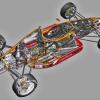What I am hoping to find with this thread is the view of insiders at a given time in history, particularly from the early 1970s through the 1980s, as this is a period I have memories of myself.
Admittedly, it is always easy with the benefit of hindsight to point out how appalling design for passive safety generally was in the past relative to current standards, but the standards of the time should be viewed in the light of their own time in order for us to try to understand the thinking of those times, I suspect.
Personally, I remember a 'feeling' of passive safety improving in small increments through the 1970s, mixed with concern about greatly increasing speed combined with the drivers being situated further and further forward in cars with single-skin footwells and increasingly narrow chassis side members in the ground effect era of the early 1980s.
I remember thinking as an adoloescent arm chair enthusiast in the mid 1970s that the introduction of forward roll hoops was a significant advance (wow : ), and as we already had bag tanks, deformable (side) structures, seat belts, main roll hoops, Armco, catch fencing and increased run-off areas, Nomex clothing, medical air bottles, on-board extinguishers and full-face helmets (and bibs!) how could we possibly improve much upon that?
Of course subsequent developments would show me how wrong I was in that sentiment - but was it not a common view shared by most people actually inside racing then? It never really occured to me at the time that, for instance, shallow aluminium tubs (there's that Lola Limp connection) and single-skinned foot boxes probably weren't such a brilliant idea safety-wise - but, hey, they were modern so they must be safer than their predecessors almost by default, right?
Looking back, it now appears to me that a lot of blind eyes must have been turned on passive safety at various junctures. Alright, shallow tubs had to be wide, so they must have provided better lateral protection, right? Well, yes, if you assume that whatever it was that went into the side didn't just run right over the driver "protected" by a [flimsy] GRP 'conning tower' cockpit surround. Then with ground effects we got central tankage and wide 'crushable' side pods - good - but it did actually occur to me then that the chassis side members were becoming rather thin and the driver's legs stuck out there somewhere in front of the front wheels - a backward step for safety I thought, but I also automatically assumed that the designer's somehow made the cars more crash resistant regardless. Looking at what happened to Marc Surer (twice!) and poor Palletti seemed to indicate that frontal protection was slow in coming. Why? We also saw a multitude of badly shattered legs in Indycars in those days, and prior to that busted arms and broken necks when the shallow-tub cars rolled. Why was this allowed to go on for so long? For a couple of decades we also saw comression crumpled tubs, woefully lacking in internal substructure bulkheads, and spaceframes that were designed for stiffness only, not for strength. Why? It was well known that the drivers tended to 'ride it out', stuck in their crashing cars, even before the introduction of seat belts and roll hoops, and that the chassis then had a protecting role to perform. Surely, the drivers weren't expendable?
The basic structural engineering principles needed to significantly increase the 'crashworthiness' of either type of chassis structure were known at the time, but not applied, witness Matra's multiple-bulkhead tubs (subsequently mitigated against by compulsory bag tank rules) and the 'Sigma' concept car. Adding strength would add weight, yes, but it would be the same for everyone. Did Rindt's crumpled 1969 Barcelona tub appear to be a fluke simply because he survived almost intact (that was the flukey part!)? As did Richard Robart's later devastated F2 March? Tubs were folding up left, right and center, or being torn apart by Armco, in both cases often with ruptured tanks and a funeral pyre as the grisly finale (if the driver wasn't already minced) - why was the response of both competitors and the governing bodies to the carnage of the 1970s so slow? I recall thinking at the time that pretty much all the fatal accidents of the time were "freak accidents - you can't cover every eventuality", but the ability of doing something about it was well within the engineering capabilities of the time, even still using aluminium stressed skin chassis (or steel tubular spaceframes), and even at reasonable cost, yet it wasn't really until we got carbon fibre and we began getting used to the idea of seeing both car and driver surviving fairly major shunts that 'crashworthy' chassis began getting the attention of authorities, designers and (perhaps) drivers alike. Yet it still took the death of Senna only 11 short years ago to get the message through that the driver's head was still terribly exposed
I now believe there's always got to be room for improvement...I don't believe it's callousness that prevented progress in 'design for safety' - I think it was ignorance and complacency combined.
If there are anyone in this forum who was involved in the design and manufacture of racing cars in the 1970s and 1980s, I would like to hear what your sentiment on 'crashworthiness' was in those days (Alan Brown is one such). And, yes, I'm as much a hypocrite as the next guy - I felt invulnarable when sat in my 1980s Formula Fords and am now actually looking forward to racing my much less safe 1966 Formula Vee, although it now has an effectual roll hoop and thicker side panels. Does being engaged in motorracing somehow disengage some parts of our cognitive abilities, I wonder?












